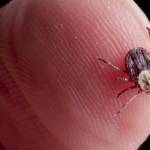Lyme Disease in Horses

Lyme disease is an illness caused by Borellia burgdorferibacteria. Humans, dogs, cats, horses, and many other species are susceptible.
How do horses get Lyme disease?
Horses and other victims can be infected only through the bite of an infected tick, usually deer ticks in the northeastern U.S.and western black-legged ticks in southeastern and western regions. It is generally thought that the tick must remain embedded for at least 12 to 24 hours for transfer of bacteria to take place, and therefore removing ticks as soon as they are found is a good idea. There is no transmission between victims, so handling an infected horse or other animal is not dangerous to humans.
How common is this disease?
In areas of the country where infected ticks are found, the majority of horses usually have antibodies to B. burgdorferi in their blood, an indication that they have been exposed to the bacteria. However, it is estimated that less than 10% of horses that test positive for antibodies will actually develop signs of Lyme disease. Diagnosis is therefore based on environment (does the horse live in an area known to be populated by infected ticks?) and history (has the horse been bitten by one or more ticks?) as well as disease signs.
What are the signs of this disease?
Lyme disease can affect horses in various ways. Signs may be subtle and may mimic those of neurologic disorders. Lameness that seems to shift from joint to joint, sensitivity to touch, irritability, behavioral changes, low energy level, weight loss, eye inflammation, and pain in the muscles or joints are some of the more common indications.
Is there a preventive vaccine for horses?
Vaccination against Lyme disease is presently available for dogs and humans, but not for horses.
Equine researchers at CornellUniversityhave had positive results in testing a recombinant outer-surface protein vaccine to prevent infection, but the vaccine is not yet available for general use. It is not expected to be helpful in treatment of horses already infected with B. burgdorferi bacteria.
What treatments are available?
Lyme disease responds to antibiotics such as tetracycline, doxycycline, and ceftiofur, with recent tests showing that intravenous tetracycline seems to be most effective. Some improvement is often seen within the first few days of treatment. Anti-inflammatory medicines are sometimes used as well as prebiotics or probiotics to support the digestive tract during antibiotic therapy. Because some horses are sensitive to the toxins given off by dying bacteria, animals being treated for Lyme disease should be closely watched for worsening disease signs or the development of laminitis.
What is the prognosis for recovery?
Especially when diagnosis and treatment are prompt, many horses respond well to several weeks of antibiotic treatment. However, some horses initially improve following treatment and then begin to show signs again after a few months. Whether this is due to reinfection or resurfacing of the original bacterial population is not known, but the same scenario is seen in infected humans. This pattern seems to be more common in individuals, whether equine or human, where the infection was established for several months before treatment was started. Veterinary attention at the first signs of illness is an important factor in complete recovery, but this is sometimes difficult due to vague and intermittent signs of Lyme infection.
How can I limit my horse’s risk of developing Lyme disease?
Preventing ticks from coming in contact with your horse is the most important step in avoiding Lyme disease. During daily grooming, pay particular attention to the mane, belly, legs, and area under the tail and remove ticks as soon as they are found. Tick repellents are helpful but must be applied several times a day for maximum effect. Keeping grass mowed, removing brush piles, and clearing fencerows will make your property less attractive to ticks.
What nutritional program is best for a horse recovering from Lyme disease?
As with any horse, an animal recovering from disease needs a diet based on high-quality forage. Pasture or clean, leafy hay should make up the majority of the horse’s intake. Horses that have been taken out of work will need to consume somewhat fewer calories until they resume training.
Fortified grain will provide energy and encourage weight gain in horses that have lost condition during the course of the illness. If the aim is to provide essential vitamins and minerals without extra calories, a supplement such as All-Phase can be fed instead of large quantities of concentrated feed. Vitamin E and selenium are essential for proper nerve and muscle function, so adequate levels of these nutrients should be supplied to horses recovering from diseases that have compromised the neuromuscular system. A veterinarian should be consulted about treatment, work schedule, and diet throughout the course of illness and recovery.








